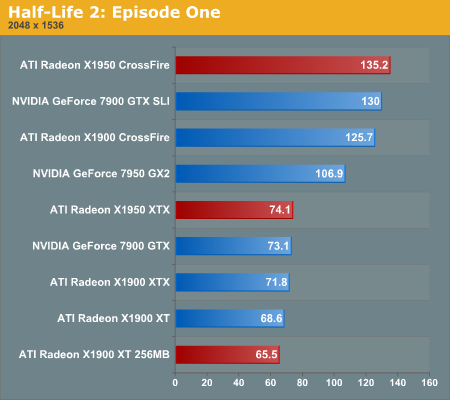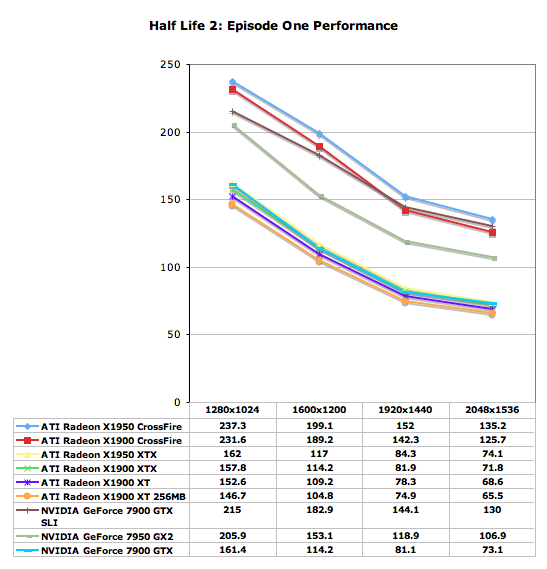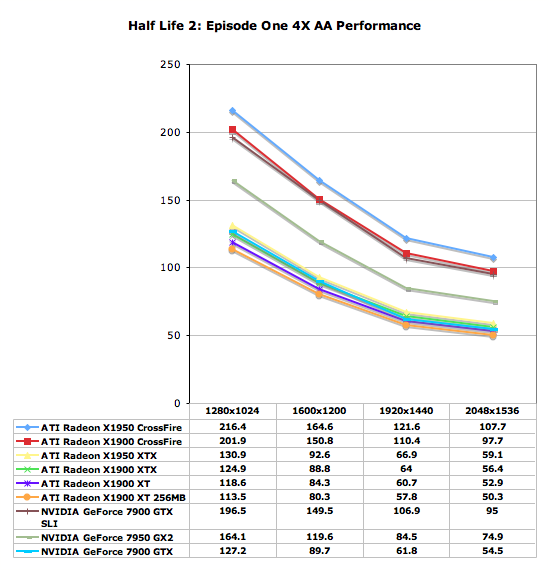ATI's New High End and Mid Range: Radeon X1950 XTX & X1900 XT 256MB
by Derek Wilson on August 23, 2006 9:52 AM EST- Posted in
- GPUs
Half-Life 2: Episode One Performance
Episode One of the new Half-Life 2 series makes use of recent Source engine updates to include Valve's HDR technology. While some people have done HDR that won't allow antialiasing (even on ATI cards), Valve put a high value on building an HDR implementation that everyone can use with whatever settings they want. Consistency of experience is usually not important enough to developers who care about pushing the bleeding edge of technology, so we are very happy to see Valve going down this path.
We use the built-in timedemo feature to benchmark the game. Our timedemo consists of a protracted rocket launcher fight and features much debris and pyrotechnics. The source engine timedemo feature is more like the nettimedemo of Id's Doom 3 engine, in that it plays back more than just the graphics. In fact, Valve includes some fairly intensive diagnostic tools that will reveal almost everything about every object in a scene. We haven't found a good use for this in the context of reviewing computer hardware, but our options are always open.
The highest visual quality settings possible were used including the "reflect all" setting which is normally not enabled by default. Antialiasing was left disabled for this test, and anisotropic filtering was set at 8x. While the Source engine is notorious for giving great framerates for almost any hardware setup, we find the game isn't as enjoyable if it isn't running at at least 30fps. This is very attainable even at the highest resolution we tested on most cards, and thus our target framerate is a little higher in this game than others.


Most of the solutions scale the same in Half-Life 2: Episode 1, with the possible exception of the 7900 GTX SLI setup hitting a bit of an NVIDIA driver inspired CPU limitation at 1280x1024. We can't really complain, as scoring over 200 fps is really an accomplishment in itself. With scores like these across the board, there's no reason not to run with AA enabled.


With even the slowest tested solution offering over 50 FPS at 2048x1536 4xAA, gamers playing HL2 variants can run with any of the high-end GPU solutions without problem. ATI does manage to claim a ~10% performance victory with the X1950 CrossFire over the 7900 GTX SLI, so if the pattern holds in future episodes ATI will be a slightly faster solution. The X1900 CrossFire configuration was also slightly faster than the SLI setup, though for all practical purposes that matchup is a tie.










74 Comments
View All Comments
nextsmallthing - Wednesday, August 23, 2006 - link
Did anyone else notice that the specs for some of the NVIDIA cards are wrong? For example, the core clock of the 7900GTX is supposed to be 650 MHz, not 700 MHz, and the core clock of the 7900GT should be 450 MHz, not 470 MHz. Also, the pipeline configuration for the 7300GT (according to Wikipedia anyway) should be 8 pixel & 4 vertex.This many mistakes really makes me question the accuracy of other specs I read on Anandtech.
(And by the way, would somebody please inform the DailyTech writers that it's "Xbox 360", not "XBOX 360". And yes I'm aware of the conventions that punctuation goes inside quotes and you shouldn't start sentences with "and".)
Anand Lal Shimpi - Wednesday, August 23, 2006 - link
The 7900GTX/GT clock speeds that were listed were actually vertex clock speeds, not general core clock speeds, so they were technically correct (parts of the GPU do run at those frequencies) just not comparable to the other numbers. They have been corrected.The 7300GT is indeed 8 pipes, that was a copy/paste error. Thanks for the heads up.
Take care,
Anand
nextsmallthing - Thursday, August 24, 2006 - link
Wow--prompt correction and courteous reply. I'm impressed, and my faith in Anandtech is restored!Josh7289 - Wednesday, August 23, 2006 - link
From the looks of the pricing structure for ATI's cards on the first page, and especially from the looks of the pricing structure for ATI's cards after they simplify their lineup, it looks like ATI is giving up on midrange cards, from $100 - $200. The 7600GT and the upcoming 7900GS both are alone in that price range (about $150 and $200, respecitively), with no competition from ATI, so it seems they really are giving that price range to Nvidia.Am I right with this or am I seriously missing something?
yyrkoon - Wednesday, August 23, 2006 - link
there is a x1800GTO2, price last I looked was around $230, of course, they released it rather quietly. Still, thats about $90 higher than the 7600 GT (or in my case the eVGA 7600GT KO).OrSin - Wednesday, August 23, 2006 - link
I wondering the same thing. Are they going to stop making any 1800's. They should be dropping in this price range nicely. Not sure how competative they are with the 7900's. And now that the 7900GS is coming out the 1800 might be just too outclassed. (you guys just missed a great deal on woot 7900GS for $145).I hope 1800 drop is still being made and I hope it drops to $150-180 range to fill that gap.
JarredWalton - Wednesday, August 23, 2006 - link
I think they've already stopped making all of the X1800 series, but there are still cards floating around.Josh7289 - Wednesday, August 23, 2006 - link
The X1900GT is a card meant to compete with the stock 7900GT, and as such is somewhere around the $200 - $250 price range.As for the X1950 Pro and X1650 XT, what are these supposed to compete against and at what prices. More importantly, when are these supposed to launch?
coldpower27 - Wednesday, August 23, 2006 - link
As well the X1650 XT is also in the works.coldpower27 - Wednesday, August 23, 2006 - link
X1950 Pro, is upcoming, as well they still have the X1900 GT.